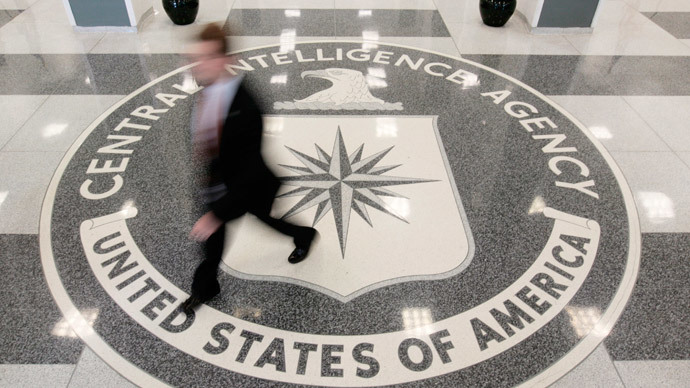CIA lied about torture’s effectiveness, according to unreleased Senate report

A Senate report found that CIA officials lied to the government and public about its post-9/11 torture program, most notably by distorting intelligence gleaned from traditional interrogations as that attained by far more brutal methods.
The Washington Post reported Monday that the Senate Intelligence Committee’s report outlines a long list of “unsubstantiated claims” from CIA officials in the agency’s pursuit of a global torture regime that resulted in little, if any, substantive intelligence, according to US officials who have reviewed the document.
“The CIA described [its program] repeatedly both to the Department of Justice and eventually to Congress as getting unique, otherwise unobtainable intelligence that helped disrupt terrorist plots and save thousands of lives,” said one US official briefed on the report. “Was that actually true? The answer is ‘no’.”
The report is the culmination of reviewed materials compiled by an internal CIA audit of around 6.2 million pages of emails, operational cables, and other secret documents made available to the Committee in a secret electronic reading room at the CIA’s Langley headquarters.
The report has yet to be released by the Committee, as it has been the subject of intra-government wrangling and hand-wringing since December 2012, when a final draft of the 6,300-page study was completed.
The classified files reviewed by Committee investigators include new disclosures about the worldwide network of “black sites” where prisoners were rendered after capture in Iraq and Afghanistan, or by kidnapping.
The report shows internal divisions in the CIA over the torture program, including one instance when employees left a secret prison in Thailand after disturbing coercion techniques were used against detainees. The study also reveals cases where CIA officials in the US demanded torture methods continue despite analysts’ view that prisoners had no information to offer.
Officials told the Post that some of the most damning findings in the Committee’s report pertain to differences between statements senior CIA officials in Washington have made as opposed to written notes from CIA employees involved in the interrogations.
According to the Post’s anonymous sources, millions of records make clear that the CIA was able to obtain most of its valuable intelligence against Al-Qaeda, including the whereabouts of Osama bin Laden, without use of so-called “enhanced interrogation techniques.”
As has been reported elsewhere, intelligence gathered from a detainee known as Abu Zubaydah was obtained by FBI sources, mainly agent Ali Soufan, in a hospital in Pakistan, before the CIA waterboarded Zubaydah 83 times. Yet Soufan’s work was passed through US intelligence sources as though it was part of CIA interrogators’ work, the Committee’s report found.
“The CIA conflated what was gotten when, which led them to misrepresent the effectiveness of the program,” said another US official who has access to the report. The officials described the continued repetition of these misstatements as “the most damaging” of the Committee’s conclusions.
In addition, the report found that detainees’ credentials were often distorted. Zubaydah, for example, was called a senior Al-Qaeda operative, yet experts later found him to be a simple facilitator who would guide recruits to Qaeda training camps.
Likewise, Abd Al-Rahim Al-Nashiri was called “mastermind” by CIA officials of the 2000 bombing of the USS Cole in Yemen, yet the title was found to be an overstatement. An Al-Qaeda operative, Hassan Ghul, who provided critical insight into finding Osama bin Laden had offered his most critical intelligence during an interrogation with Kurdish authorities in northern Iraq, not during his later stint in a black site prison in Romania, officials said.
The Committee’s report also involves new information into torture methods employed by the CIA.
Ali Abdul Aziz Ali - a nephew of Khalid Sheik Mohammed, self-proclaimed planner of the September 11, 2001 attacks - was captured in Pakistan in April 2003 and turned over to the CIA a week later. Ali, better known as Ammar Al-Baluchi, was taken to a CIA black site called “Salt Pit” in Kabul, Afghanistan.
At Salt Pit, Baluchi was repeatedly dunked in a tub of ice water. Interrogators would hold his head under the icy water, beat him repeatedly with a “truncheon-like object,” and slam his head against a wall, officials told the Post.
As with other detainees like Zubaydah, CIA interrogators continued the treatment even after Baluchi had cooperated. He was later flown to a new black site in Romania, and, in 2006, taken to the military prison at Guantanamo Bay, Cuba. His attorneys have said he suffered head trauma while in CIA custody.
When the Committee asked Baluchi’s attorneys for information about his medical condition sometime last year, military prosecutors denied the request, calling it outside the Committee’s investigation.
Two Libyan terror suspects – Mohammed Al-Shoroeiya and Khalid Al-Sharif – experienced similar torture at Salt Pit, Human Rights Watch has said. One of the men said CIA interrogators “would pour buckets of very cold water over his nose and mouth to the point that he felt he would suffocate. Icy cold water was also poured over his body. He said it happened over and over again,” according to the Committee report.
CIA doctors would monitor detainees’ body temperatures as to avoid hypothermia.
The CIA maintains that these prisoners were not waterboarded and that the tactic was only used on three prisoners – Mohammed, Zubaydah, and Nashiri.
The Senate Intelligence Committee’s report is divided into three volumes, the officials said. The chapters pertain to the chronology of interrogation operations, intelligence officials’ claims, and case studies on almost every prisoner the CIA has held in the past 13 years. The report does not include locations of CIA prisons or the names of agency employees who were not supervisor level.
The US officials knowledgeable of the report said the Committee did not assign motives to the CIA officials whose actions and statements were probed, nor does the report recommend any further punishment or criminal inquiry for the torture program that the US Justice Department has investigated already. To date, no major or mid-level US officials have been held legally accountable for the CIA’s interrogation tactics.
For its part, the CIA said it would not comment to the Post, as it has not yet seen the final version of the report, a spokesman said.
Yet the Post noted that many current and former CIA officials have privately claimed the Committee’s report was full of errors, “misguided conclusions,” and held an overall view of events that adhered to FBI biases.
Committee Chair Dianne Feinstein took to the Senate floor weeks ago to claim the CIA had spied on the Committee’s investigators as it compiled its review, highlighting an ongoing feud between the agency and the Committee since the probe began in 2009.
The Committee is expected to vote Thursday to send an executive summary of the report to President Obama for eventual declassification.
The report is considered the most comprehensive account thus far of the CIA interrogation program following the Sept. 11, 2001 attacks.














